Welcome to our blog post, where we unveil “The Orchard Keeper’s Calendar: Essential Month-wise Maintenance Tips for Berry Fruit Orchards.” Maintaining a berry orchard can be a rewarding but intricate endeavor. To simplify the process, we’ve compiled a comprehensive month-wise maintenance guide to help you nurture your orchard throughout the year.

Each month presents unique challenges and opportunities, and our expert-backed tips provide accurate data and insights to ensure your orchard thrives. From pruning techniques to pest control, we’ll cover it all.
Berry Orchard Management
What is Blackberry Farming and its Overview?
Blackberry farming involves the cultivation of edible fruits produced by various species within the genus Rubus in the family Rosaceae. The taxonomy of blackberries has been historically complex due to hybridization and apomixis, resulting in species being grouped as aggregates. Blackberries are perennial plants that produce biennial stems called canes from their perennial root system.
During the first year, a new primocane stem grows vigorously but does not produce flowers. The cane becomes a floricane in the second year, and lateral buds develop into flowering laterals. Prickles, often mistaken for thorns, can be found on first- and second-year shoots, challenging navigation around the plant. However, prickle-free cultivars have been developed.
If left unmanaged, Blackberry plants form dense arching stems that root from the node tip when they touch the ground. They are fast-growing and thrive in woods, scrub, hillsides, and hedgerows. These resilient shrubs tolerate poor soils and readily colonize wastelands, ditches, and vacant lots. The flowers of blackberry plants bloom in late spring and early summer, appearing as short racemes on the tips of the flowering laterals. Each flower has five white or pale pink petals measuring 2-3 cm in diameter.
The development of drupelets, the individual segments of blackberry fruit, depends on the successful fertilization of ovules by pollen grains. Inadequate pollinator visits, caused by unfavorable weather conditions or insufficient bee activity, can lead to undeveloped ovules and lower fruit quality. Incomplete drupelet development may indicate depleted root reserves or viral infections such as a raspberry bushy dwarf virus.
In case you missed it: Optimizing Grapes Orchard Management: A Month-by-Month Maintenance Guide for High Yield and Profit
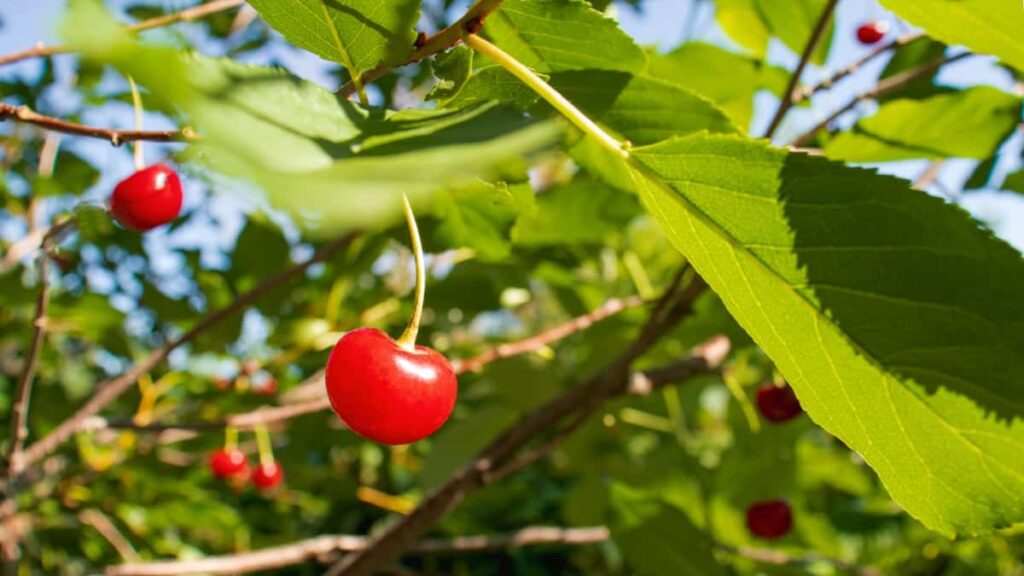
Importance of Month-Wise Planning for Blackberry Orchard Maintenance
- Pruning blackberry plants at the optimum time promotes growth, ventilation, and fruit production.
- Disease and Pest Management: Preventive techniques and seasonal treatments control common diseases and pests, protecting the orchard.
- Fertilization and Irrigation: A month-by-month schedule ensures timely fertilizer and irrigation, delivering needed nutrients and water for plant growth.
- Support Maintenance: Inspecting and maintaining trellises and supports during particular months prevents structural damage and optimizes plant support.
- Orchard owners may harvest blackberries at their best flavor and quality by measuring their monthly growth.
- Winter Protection: Mulching and shielding plants from cold temperatures ensures their survival and vitality for winter.
- Following a month-by-month management plan, Blackberry orchard owners can maximize yields, mitigate damage, and preserve orchard health and productivity.
Best Tips for Cultivation/Growing of Blackberry Orchard Maintenance Practices
Choose the Right Varieties: Select blackberry varieties well-suited for your growing zone. Popular choices include ‘Navaho,’ ‘Arapaho,’ ‘Cherokee,’ ‘Brazos,’ ‘Shawnee,’ ‘Cheyenne,’ ‘Black Satin,’ and ‘Olallie.’
Planting and Site Preparation: Plant blackberries in early spring when the canes are dormant or in winter in a mild climate. Ensure the planting site receives full sun and has fertile, well-draining soil. Keep a good distance from wild blackberries to prevent the spread of diseases.
Proper Spacing and Trellising: Space the plants according to their growth habit. Semi-erect varieties need about 5 to 6 feet of space, erect varieties require 3 feet, and trailing varieties should be spaced 5 to 8 feet apart. Trellis trailing blackberries using a two-wire system to support the canes. Use a trellis system to support trailing or semi-erect blackberry varieties. A “tomato” style cage can suffice for a few plants, while a wire trellis system is ideal for multiple plants.
Mulching and Watering: Apply a thick mulching layer to conserve moisture and suppress weeds. Blackberries require regular watering, aiming for 2-3 weekly waterings and more during hot weather.
Fertilization: Fertilize blackberries in early spring with an all-purpose fertilizer such as 10-10-10 or 16-16-8 to provide nutrients for healthy growth and fruit production. Apply aged compost around blackberry plants in spring. Once buds appear, spray them with fish emulsion or another organic fertilizer.
In case you missed it: Optimizing Banana Orchard Management: A Month-by-Month Maintenance Guide for Maximum Yield
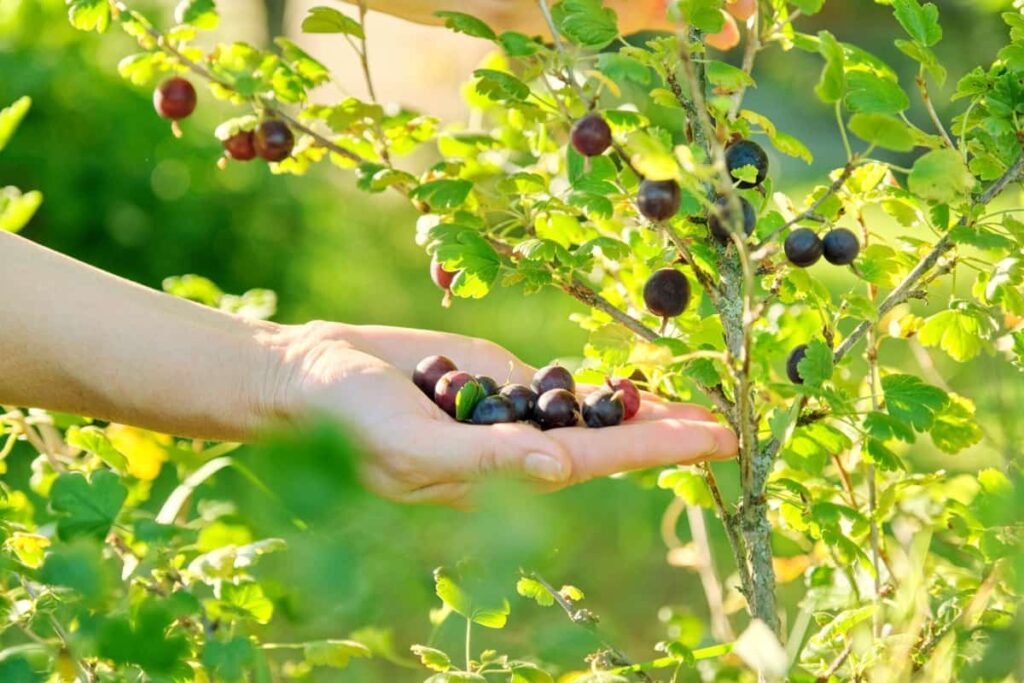
Pruning Techniques: Prune blackberries annually to maintain plant health and encourage optimal fruiting. Remove old canes after fruiting, train new canes along trellises, and tip canes at appropriate heights to stimulate branching.
Harvesting Tips: Harvest blackberries when fully black, plump, and pull easily from the plant. Pick berries every couple of days once they start ripening. Harvest during the early and cooler times of the day and refrigerate them promptly.
Storage and Preservation: Blackberries are highly perishable and should be consumed or preserved soon after harvesting. They can be canned, preserved, or frozen using techniques similar to freezing blueberries.
Pest and Disease Management: Watch out for common pests and diseases like raspberry borers, fruit worms, gray mold, and viruses. Take preventive measures such as regular inspection, proper sanitation, and timely treatment to protect your plants.
Health Benefits: Blackberries are rich in antioxidants like ellagic acid, which can help reduce the risk of cancer and cardiovascular diseases. Enjoy the nutritional benefits of blackberries as part of a balanced diet.
Common Problems and Solutions: Address specific issues like crown gall by practicing good sanitation, cleaning tools with bleach, and considering solarization. Control raspberry borers by manually removing adults and applying neem oil. Combat diseases like orange rust and anthracnose by removing infected parts and using appropriate fungicides. Protect blackberries from birds using netting. Prevent powdery mildew by planting resistant varieties, ensuring proper air circulation, and removing infected canes. Control leafrollers by handpicking or using Bacillus thuringiensis-based poison.
Companion Plants: Plant low-growing perennials like tansy, hyssop, mint, chives, blueberries, beans, garlic, grapes, and borage around blackberries. Avoid planting near nightshade family plants and raspberries.
Harvesting and Storing: Harvest blackberries when fully black, plump, and firm. Store in the refrigerator or a cool location, as they have a short shelf life of 5-7 days. Plan for utilizing the harvest in various culinary applications, freezing, canning, or making jam.
Foraging for Wild Blackberries: Exercise caution when foraging wild blackberries, distinguishing them from poison ivy. Be mindful of invasive blackberry varieties in certain regions, ensuring the safety of plants before consumption.
January Month Blackberry Orchard Maintenance Planning
- Now is the time to prune blackberries. Remove any dead or broken canes and any weak or overcrowded growth. Pruning encourages plant growth.
- Limb Spreading: Peg trees or limb spreaders can aid in branching blackberry plants. These instruments shape and improve the movement of light and air.
- Keep sensitive plants away from frigid temperatures.
- Planting Fruit Trees: Without a watering plan, January is a wonderful time to establish fruit trees. Water the trees as they are established.
In case you missed it: Optimizing Oil Palm Orchard Management with Month-wise Operations for High Yield and Profit
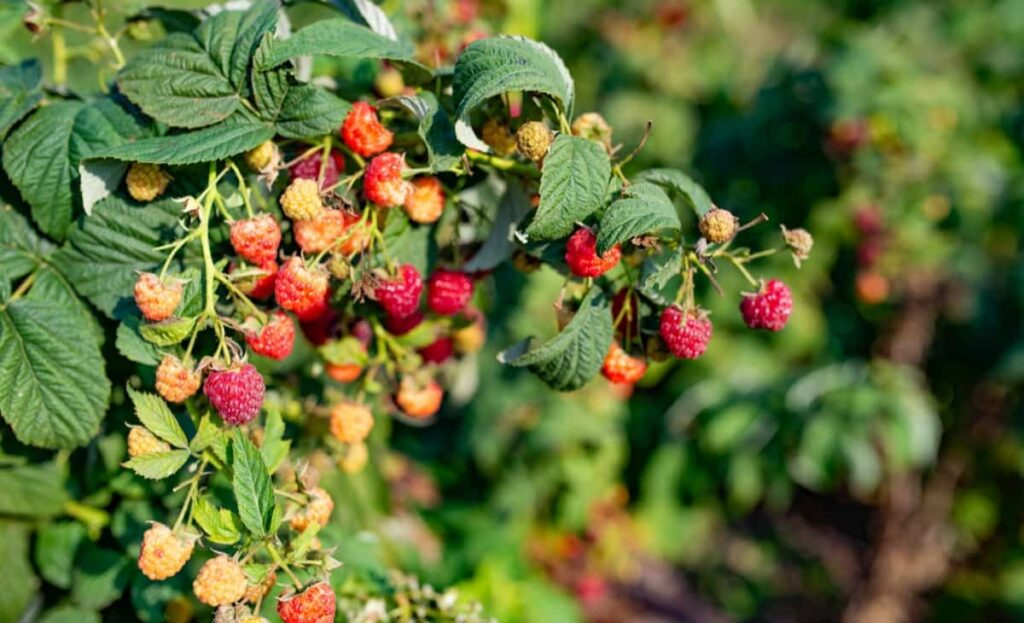
February Month Blackberry Orchard Maintenance Planning
- Pruning: Remove dead, damaged, and weak blackberry canes in February. Reduce crowding to increase airflow and light. This boosts growth and lowers disease risk.
- Control Weeds around blackberries. Remove weeds and mulch to prevent new growth. This reduces nutrient and water competition.
- Fertilization: Use a balanced berry plant fertilizer in February. To nourish growth, follow dose directions.
- Irrigation: Monitor soil moisture and irrigate as needed. During dry seasons, blackberries need continuous moisture. Water them weekly.
- Aphids, spider mites, and cane borers are frequent blackberry pests. Check plants for pests and take action.
March Month Blackberry Orchard Maintenance Planning
- Trellis Maintenance: Check and repair trailing or semi-erect Blackberry trellis systems. Replace damaged wires and supports and ensure the trellis can hold developing canes.
- Replace Blackberry Mulch as needed. Mulch controls soil temperature, moisture, and weeds. Keep mulch thick and away from plant stems.
- Disease Prevention: Watch for anthracnose and powdery mildew. Remove and discard damaged plant parts if found. Apply labeled fungicides.
- Blackberries establish fruit with pollinators. Plant pollinator-attracting blooms. Pollination and fruit output increase.
April Month Blackberry Orchard Maintenance Planning
- Weed Control: Maintain weed control around the blackberry orchard. Enclose them regularly to avoid weeds competing with blackberry plants for nutrients and water.
- Watering: As the weather heats, increase irrigation frequency and amount to keep blackberry plants hydrated. Fruit growth needs moisture.
- Berry Thinning: Thin surplus fruit clusters to grow bigger, better berries. Remove damaged or deformed fruits to let the rest develop and mature.
- Aphids, spider mites, and Japanese beetles should be monitored. To prevent plant infestations, use insecticidal soaps or organic insecticides.
May Month Blackberry Orchard Maintenance Planning
- Blackberry trimming is necessary in May. After fruiting, remove floricanes (second-year canes) to promote growth. Thin canes to optimize airflow and disease pressure.
- Disease Control: Watch for cane blight and crown gall in blackberries. To stop diseases, remove and destroy diseased plant components immediately. Fungicides may be needed.
- Check and reinforce trellis systems to support expanding canes. Attach the canes along the trellis wires to prevent wind or fruit weight damage.
- Irrigation: Keep soil hydrated. To promote healthy root growth, water deeply and according to weather conditions.
In case you missed it: Almond Orchard Management: Month-by-Month Maintenance Guide for Maximum Yield
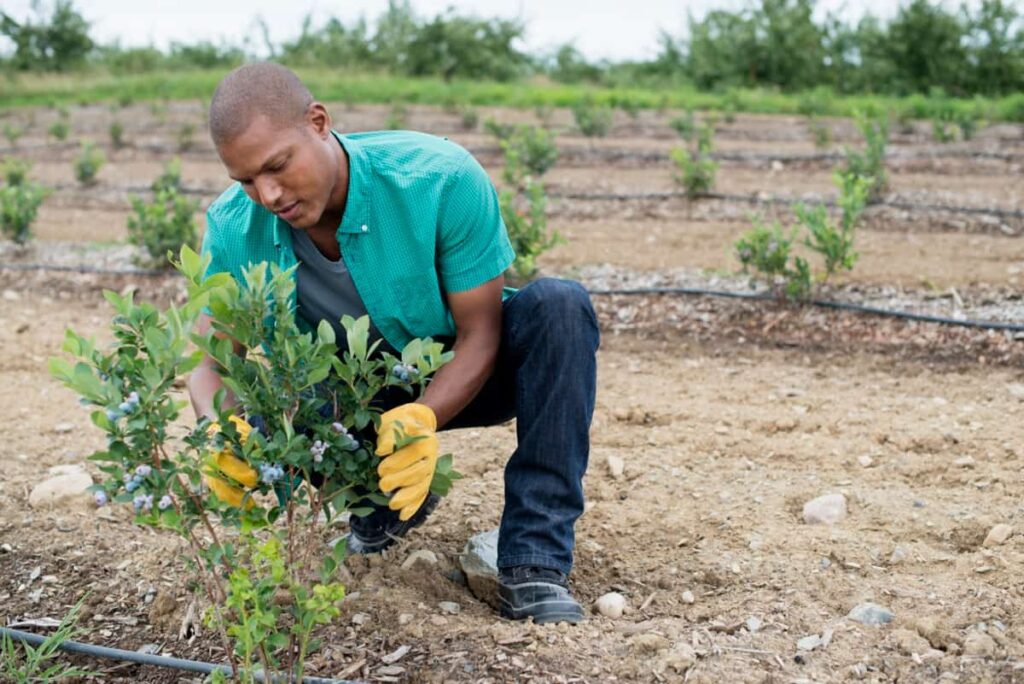
June Month Blackberry Orchard Maintenance Planning
- Weed Control: Remove new weeds. Mulch blackberry plants to prevent weeds and retain soil moisture. Monitor and control weeds to avoid competition.
- In June, use a balanced blackberry fertilizer. Follow dose directions for growth and fruit development.
- Pests and Diseases: Watch for spotted wing drosophila and raspberry crown borers. Use IPM-based pest control methods. Detect and treat illnesses.
- Pruning and Training: Secure the canes along the trellis. Maintain a well-ventilated canopy by removing superfluous canes and lateral branches. Pruning improves light and airflow.
July Month Blackberry Orchard Maintenance Planning
- Irrigation: Water blackberry plants in summer. Check soil moisture and adjust irrigation frequency and duration. Deep watering helps plants and fruit grow.
- Mulching: Check and replenish blackberry plant mulch. Mulch controls soil temperature, moisture, and weeds. Keep mulch thick.
- Pest Control: Watch for Japanese beetles and aphids. Use traps, targeted insecticides, or physical removal to manage pests.
- Harvest ripe blackberries. Pick them when the berries are black, plump, and readily detached. Check plants for ripe fruit to harvest on time.
August Month Blackberry Orchard Maintenance Planning
- Pruning: Remove fruited floricanes (fruiting canes) after harvest. These canes can be cut low since they won’t bear fruit again. Leave primocanes for next year.
- Soil Moisture: Check and water as needed. Moisture helps plants generate new canes.
- Disease Management: Watch for rust and powdery mildew. Remove diseased plant sections and apply fungicides to prevent spread.
- Weed Control: Remove new weeds routinely. Mulching blackberry plants prevents weeds and conserves moisture.
September Month Blackberry Orchard Maintenance Planning
- Trellis Maintenance: Check and fix the trellis to support the canes. Remove broken or weak parts and realign the canes.
- Fertilization: Apply a blackberry-specific balanced fertilizer in September. Follow dosage requirements for new cane growth and plant health.
- Weed Control: To avoid blackberry competition, monitor and control weeds. Keep weeds away from plants.
- Irrigation: Adjust irrigation according to weather and plant needs. For new cane growth and next year’s fruiting, irrigate blackberry plants.
October Month Blackberry Orchard Maintenance Planning
- Pruning: Remove overgrown or undesirable blackberry canes. To maintain plant health, remove sick, damaged, or weak canes. Thin canes for airflow.
- To prevent weeds and retain soil moisture, mulch blackberry plants. To avoid water buildup, leave space around plants.
- Soil Testing: Check pH and nutrient levels. Based on the test results, fertilize or amend the soil to optimize blackberry plant growth.
- Check for stink bugs and aphids. Protect plants and produce with pest control.
In case you missed it: Mastering the Dragon Fruit Orchard Management: A Month-by-Month Operations Guide for Maximum Yield
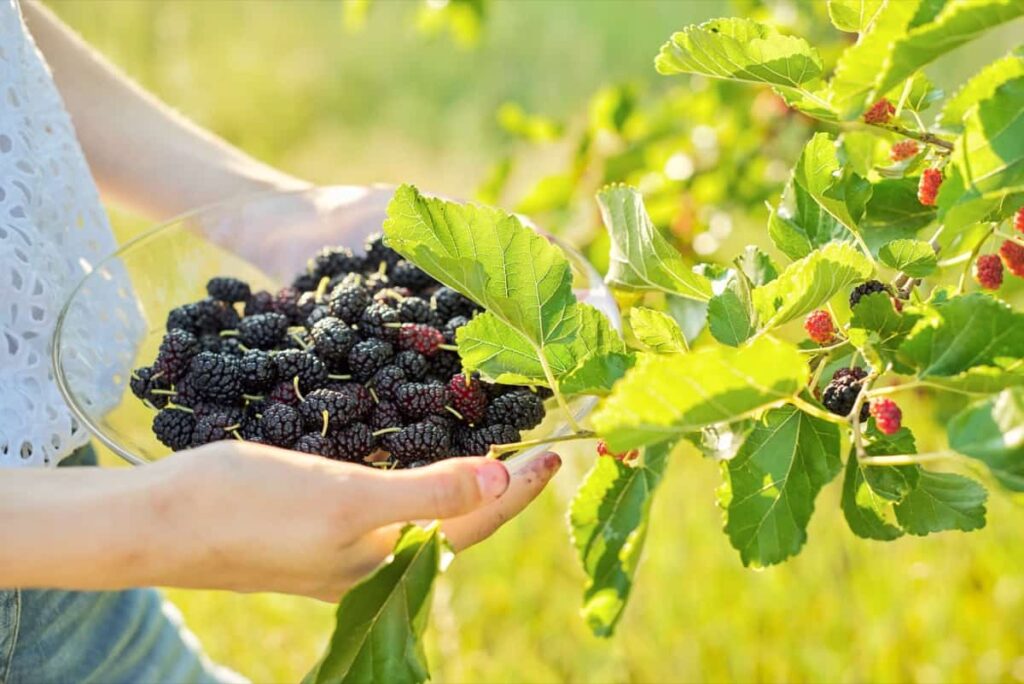
November Month Blackberry Orchard Maintenance Planning
- Winter Protection: Protect the blackberry plants from the elements during the winter. Set up windbreaks or barriers to protect the plants from strong gusts and freezing temperatures.
- Pruning: Remove any residuals that have stopped producing from the blackberry plants.
- Mulching: Apply a heavy layer of mulch around the base of the blackberry plants to protect the roots from freezing temperatures. Mulch also helps to conserve soil moisture during the cold months.
- Pruning tools and other equipment must be cleaned and stored to avoid rust and damage. Prepare them for the next growing season.
December Month Blackberry Orchard Maintenance Planning
- Winter Care: Look for broken canes on blackberry plants. Remove damaged parts to prevent disease and pests.
- Irrigation: Adjust irrigation according to weather and plant needs. Maintain plant moisture during dormancy by watering less.
- Soil Health: Test pH and nutrient levels. Improve soil fertility for the growing season by amending it.
- Preparation: Plan the upcoming growing season in winter. Review last year’s performance, order supplies, and plan pruning, fertilizing, and planting.
Conclusion
Maintaining a berry orchard requires diligent month-wise maintenance. Each month, from pruning and fertilizing to weed control and pest management, presents unique tasks. Following a well-planned calendar and implementing essential maintenance tips, orchard keepers can ensure their berry orchards’ health, productivity, and longevity throughout the year.
- Profitable Village Farming Business Ideas in 2024
- High-Yield Aquaculture: Fast-Growing Fish for Farming
- Effective Fish Pond Construction Techniques for Beginners
- Irrigation and Water Management in Pineapple Farming
- Blossom to Harvest: Mastering Flowering and Pollination in Papaya Farming
- Pig Fattening Essentials: From Selection to Sale for Beginners
- Raising Wagyu Cattle: A Complete Guide for Premium Beef Production
- Soil Types and Their Water Holding Capacity
- Optimizing Irrigation Schedules for Coconut Groves for Enhanced Yield
- Espresso Your Garden: Coffee Grounds for Healthier Acid-Loving Plants
- The Best Soil Mix for Snake Plants: How to Mix Your Own Snake Plant Soil
- Green Thumb Success: Expert Tips for Cultivating Greenhouse Beans All Year Round
- Bloom All Year Round: The Ultimate Guide to Indoor Hyacinth Care
- Eco-Friendly Gardening: How to Make Liquid Fertilizer from Kitchen Waste
- Ultimate Guide to Grow Anise in Pots: Explore Seed Propagation to Harvesting
- Guide to Raising Chester White Pigs: Discover Breed Facts to Growth Management
- Mastering the Elegance: The Ultimate Guide to Weeping Cherry Tree Care, Planting, and Maintenance
- Ultimate Guide to Planting Garlic in Grow Bags: Growing Strategies for Beginners
- How to Fix Spider Plant Leaf-Related Problems: Natural and Organic Remedies
- 10 Reasons Why Your Tulsi Plant is Shedding Leaves: Home Remedies and Solutions
- Optimizing Growth and Yield: The Advantages of Palm Bunch Ash Fertilizer
- Utilizing Neem Oil Extract as a Natural Pesticide for Hydrangea
- From Soil to Harvest: Various Ways in Which Farmers Can Use AI Tools
- Steps to Encourage and Induce Citrus Flowers: A Comprehensive Guide
- How to Fix Snake Plant Leaf-Related Issues: Natural and Organic Remedies
- Transform Your Garden into a Fragrant Oasis with Raat Ki Rani (Night Blooming Jasmine)
- Discover the Ideal Chicken Breeds for Philippine Farms
- How to Create a Poultry Egg Farm Business Plan for Profits
- Grow Lemon Cucumbers Like a Pro: Insider Techniques for Bountiful Yields
- Ultimate Guide to Caring for Your Pink Princess Philodendron: Tips for Thriving Variegation
- Areca Nut Profit Per Acre: Calculating Yield and Cost of Cultivation
- How Kaveri Chicken is Becoming a More Profitable Breed in Indian Backyards
- Transform Your Barn: 9 Steps to Convert a Horse Stall into a Chicken Coop
- Exploring Suffolk Sheep Disadvantages with Limitations and Challenges
- Guide to Solving Potted Lemon Tree Problems: How to Revive Lemon Tree in Containers
- Steps to Encourage Female Pumpkin Flowers: Best Strategies for More Flowers and High Yields
